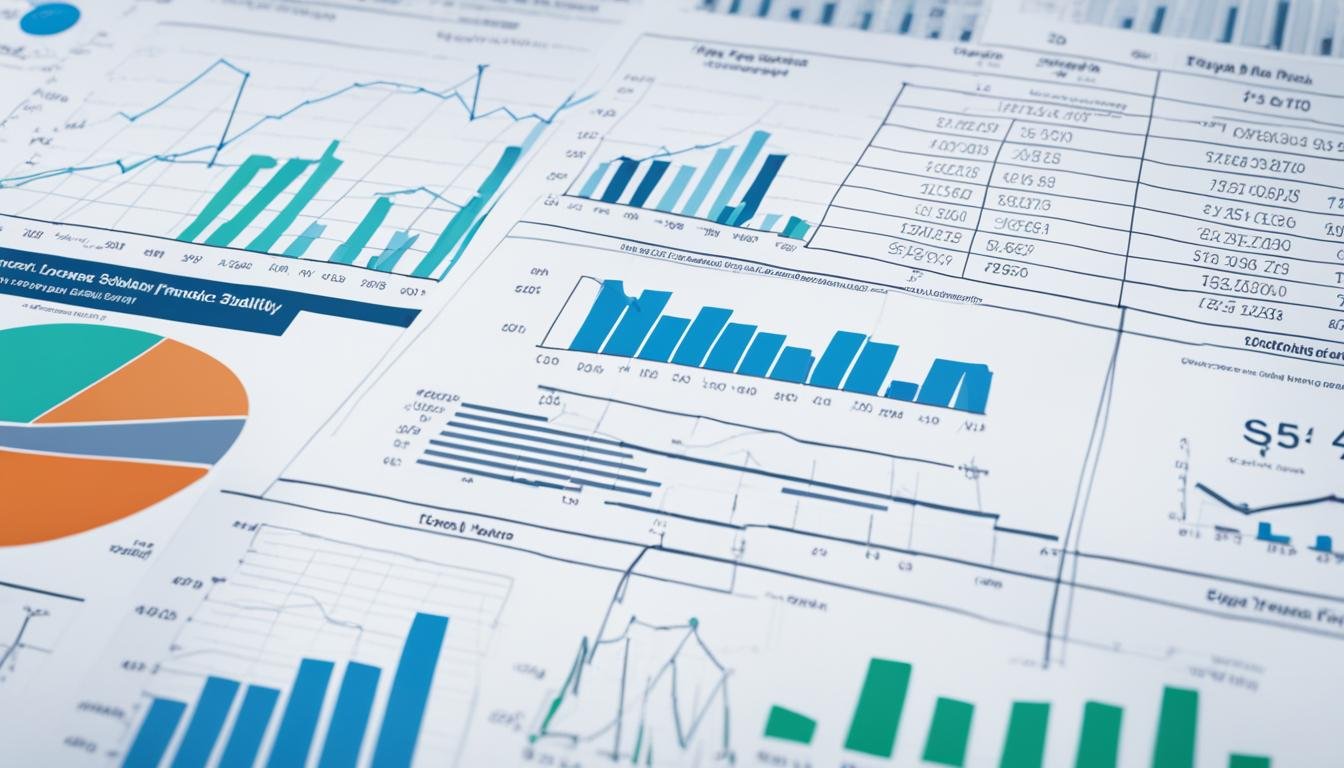Strategic Budgeting and Forecasting Insights
Effective budgeting and forecasting are key components of strategic financial planning and management. They provide valuable insights and help organizations set realistic financial goals, make informed decisions, and allocate resources effectively. In this article, we will explore the processes of budgeting and forecasting, their benefits, and key differences. We will also provide practical tips to enhance your budgeting and forecasting skills.
Key Takeaways:
- Budgeting and forecasting are crucial for strategic financial planning and management.
- They provide insights and help set realistic financial goals.
- Effective budgeting and forecasting improve decision-making and resource allocation.
- Regular review and revision of budgets and forecasts lead to continuous improvement.
- Using reliable data sources and appropriate tools enhances the accuracy and efficiency of the process.
What is Budgeting?
Budgeting is the process of planning a company’s revenue and expenses for a specific period. It involves estimating cash flow, debt reduction, and setting up budgets that can be adjusted as revenues fluctuate. The budget is compared with actual financial statements to calculate variances. This process allows management to assess financial progress, make informed decisions, and allocate resources accordingly.
During the budgeting process, organizations analyze their financial goals and determine the financial resources needed to achieve them. By carefully examining revenue streams and expenditure patterns, companies can optimize their financial planning and ensure proper allocation of resources.
Effective budgeting involves several key components: forecasting expected revenue, estimating expenses, considering cash flow requirements, and addressing debt reduction strategies. By accurately forecasting revenue and carefully estimating expenses, organizations can develop realistic and achievable budgets.
Cash flow management is an integral part of budgeting. By analyzing the timing and amounts of inflows and outflows of cash, companies can anticipate potential cash flow issues and plan accordingly. A well-executed budget can help organizations identify areas for cost reduction and implement strategies to improve profitability.
Debt reduction is another important aspect of budgeting. By allocating resources towards debt repayment, organizations can reduce interest expenses, improve financial stability, and free up cash for other strategic initiatives.
Benefits of Budgeting
A well-designed budgeting process offers several benefits for organizations:
- Provides a roadmap: Budgeting allows companies to chart their financial path and align their activities with strategic business objectives.
- Facilitates financial progress assessment: By comparing actual performance with budgeted figures, organizations can identify variances and take corrective actions.
- Ensures resource allocation: Budgeting helps organizations allocate resources effectively, ensuring that funds are allocated to priority areas.
- Promotes financial transparency: Through budgeting, organizations create a transparent financial framework that promotes accountability and ownership.
- Supports informed decision-making: Budgeting provides decision-makers with the necessary financial information to make informed choices and prioritize initiatives.
Overall, budgeting serves as a critical tool for financial planning and control. It helps organizations optimize their use of resources, enhance financial performance, and achieve their strategic goals.
Next, we’ll explore the concept of forecasting and its role in strategic planning and financial management.
What is Forecasting?
Forecasting plays a crucial role in strategic planning and decision-making for organizations. By utilizing historical data and analyzing market conditions, forecasting enables management to predict financial outcomes for future months or years. This valuable technique assists in anticipating results and making informed decisions, based on past information and trends.
Unlike budgeting, which focuses on comparing actual performance to budgeted values, forecasting is concerned with projecting future financial outcomes. By leveraging accumulated data, organizations can adjust and refine forecasts as new information becomes available, ensuring accuracy and adaptability.
Forecasting allows management to proactively address challenges, identify opportunities, and allocate resources effectively. It provides a forward-looking perspective that aids in strategic planning and goal setting. By utilizing historical data and considering prevailing market conditions, organizations can better prepare for the future and optimize their financial outcomes.
The Benefits of Forecasting
Forecasting empowers organizations to:
- Make informed decisions based on historical trends and market conditions
- Anticipate and prepare for future financial outcomes
- Optimize resource allocation and budgeting strategies
- Proactively identify and address potential challenges and opportunities
- Improve overall strategic planning and goal-setting processes
Forecasting Example
To illustrate the importance of forecasting, let’s consider a fictitious retail company, ABC Clothing Co. ABC Clothing Co. wants to expand its operations into a new market segment but needs to assess the potential financial outcomes before making a significant investment. By analyzing historical sales data, consumer trends, and market conditions, the company can produce a forecast that estimates the potential revenue, costs, and overall financial performance of entering the new market. This forecast allows ABC Clothing Co. to make data-driven decisions, allocate resources effectively, and pursue growth opportunities with confidence.
Benefits of Budgeting
Budgeting is a critical aspect of financial planning for organizations. It offers numerous benefits that assist management in strategic business planning and decision-making. Let’s explore some of the key advantages of budgeting:
1. Financial Path Charting
Budgeting provides a roadmap for organizations to navigate their financial journey effectively. It helps set clear financial goals and objectives for the year, enabling companies to align their resources and efforts towards achieving them.
2. Financial Progress Assessment
By implementing a budgeting process, businesses can assess their financial progress regularly. Comparing actual financial performance against budgeted figures allows management to identify deviations, analyze variances, and take appropriate corrective actions.
3. Expense Examination
Budgeting forces management to examine expenses in detail. It prompts a thorough evaluation of costs across different departments and functions, highlighting areas where expenses can be optimized or reduced.
4. Cash Flow Anticipation
Effective budgeting enables organizations to anticipate their cash flows accurately. By forecasting revenue and expenses, companies can proactively manage their cash inflows and outflows, ensuring sufficient liquidity to meet their financial obligations.
5. Resource Allocation
Budgeting facilitates optimal resource allocation within an organization. It helps management prioritize investments, allocate funds to different departments, and determine the optimal utilization of resources to achieve strategic goals.
6. Transparency and Ownership
Budgeting promotes transparency within an organization by providing visibility into financial plans and resource allocations. It fosters accountability and ownership among employees, encouraging them to actively contribute to achieving financial targets.
7. Rapid Responses to Challenges
When unexpected financial challenges arise, budgeting enables organizations to respond quickly and effectively. By having a well-defined budget, management can make informed decisions and allocate resources in a timely manner to address emerging issues.
“Budgeting is the cornerstone of financial planning. It equips organizations with the tools and insights needed to make informed decisions and navigate through a dynamic business environment.”
While budgeting offers immense benefits, it is essential to recognize that budgets can become outdated if assumptions change. This is where forecasting plays a crucial role, allowing organizations to adapt their financial plans based on evolving circumstances.
Stay tuned for the next section where we delve into the benefits of forecasting.
Benefits of Forecasting
Forecasting plays a crucial role in helping organizations navigate the ever-changing business landscape. By analyzing trends and predicting future outcomes, forecasting provides valuable insights that can drive strategic decision-making. Here are the key benefits of incorporating forecasting into your financial management practices:
Better Business Trend Analysis
Forecasting allows organizations to stay ahead of business trends and proactively respond to market shifts.
By closely monitoring market conditions and analyzing historical data, businesses can identify emerging trends and adjust their strategies accordingly. This proactive approach enables organizations to take advantage of new opportunities and mitigate risks before they impact their bottom line.
Improved Cash Flow Management
Forecasting helps organizations effectively manage their cash flows and optimize capital requirements.
With accurate revenue and expense projections, businesses can plan and allocate their resources more efficiently. This enables them to maintain adequate liquidity, meet financial obligations, and make strategic investments to drive growth. By aligning their cash flow management with their anticipated needs, organizations can avoid cash flow gaps and ensure a healthy financial position.
Identification of Investment Opportunities
Reliable forecasts enable organizations to identify and present investment opportunities to potential investors.
By providing a clear picture of future financial performance, forecasting allows businesses to showcase their potential return on investment. Accurate projections help build investor confidence and secure funding for expansion, innovation, and other strategic initiatives. Whether it’s attracting venture capital or seeking partnerships, organizations equipped with reliable forecasts have a competitive edge in the investment arena.
Strategic Decision-Making
Forecasting empowers managers to make data-driven decisions aligned with short-term goals and long-term strategy.
When armed with reliable forecasts, managers can evaluate different scenarios, assess the impact of various decisions, and choose the most favorable course of action. By relying on data rather than gut feelings or guesswork, strategic decision-making becomes more objective, precise, and aligned with the organization’s overall vision and objectives.
Forecasting provides valuable insights that drive accurate decision-making, enhance cash flow management, and unlock investment opportunities. By leveraging historical data and making data-driven projections, organizations can navigate the complexities of today’s business landscape with confidence and strategic vision.
Budgeting vs. Forecasting: Key Differences Explained
When it comes to financial planning, budgeting and forecasting are two essential processes that organizations rely on. While both serve different purposes, they work together to ensure effective strategic planning and decision-making. Understanding the key differences between budgeting and forecasting is crucial for businesses to optimize their financial management. Let’s explore these differences in more detail.
Budgeting: Planning for the Future
Budgeting involves creating a detailed plan for a specific period, typically spanning 1-5 years. It is the process of estimating and allocating resources to achieve an organization’s goals and objectives. Budgets outline projected revenues, expenses, and cash flows, providing a roadmap for financial activities. The preparation time for budgets can take several months, involving input from various departments and stakeholders. The primary focus of budgeting is internal, addressing the organization’s operational needs and priorities.
Forecasting: Predicting Future Outcomes
On the other hand, forecasting looks ahead to the rest of the current fiscal year and beyond. It is a shorter-term outlook that predicts future outcomes based on historical data and market trends. Forecasting typically covers a timeframe of 1-4 weeks and provides insights into expected revenues, expenses, and cash flows. Unlike budgets, forecasts are often disclosed to external parties such as investors to showcase the organization’s projected performance. Forecasts rely on up-to-date actuals, making them more reliable as they consider the latest business conditions.
Both budgeting and forecasting are critical for effective financial management and strategic planning. While budgets provide a comprehensive plan for the future, forecasts refine and adjust those plans based on new information and market conditions. By combining the strengths of both processes, organizations can make informed decisions and adapt to changing circumstances.
“Budgeting helps organizations plan for the future, while forecasting helps them adjust to the present.”
Set SMART Objectives
Setting SMART objectives is a crucial component of strategic planning. SMART refers to specific, measurable, achievable, relevant, and time-bound objectives. By incorporating these elements, leaders can effectively define clear goals, track progress, and make necessary adjustments.
SMART objectives provide organizations with clarity, ensuring that everyone understands the desired outcome and how to achieve it. The specificity of these objectives helps eliminate ambiguity and provides a clear focus for the team. Measurability enables progress monitoring and evaluation, allowing leaders to determine if objectives are being met.
Achievability is an important aspect of SMART objectives as it ensures that goals are realistic and attainable within the given resources and timeframe. By setting achievable objectives, leaders can empower and motivate their team by providing them with challenging yet realistic goals.
SMART objectives are also relevant, meaning they align with the organization’s strategic priorities and overall mission. By setting objectives that are relevant to the organization’s goals, leaders ensure that resources and efforts are directed towards meaningful outcomes.
Finally, SMART objectives are time-bound, meaning they have a specific deadline or timeframe for completion. This time constraint adds a sense of urgency and accountability, helping to prioritize actions and measure progress against defined milestones.
By setting SMART objectives, leaders can enhance their strategic planning skills in budgeting and forecasting. These objectives provide a framework for effective goal-setting and ensure that resources are aligned with the strategic direction of the organization.
Implementing SMART objectives in the budgeting and forecasting process not only facilitates better planning but also enables leaders to monitor progress, make data-driven decisions, and adjust strategies as needed.
“By setting specific, measurable, achievable, relevant, and time-bound objectives, organizations can maximize their strategic planning efforts and achieve their desired financial outcomes.”
Take a look at the table below for a visual summary of SMART objectives:
| Element | Description |
|---|---|
| Specific | Clear and well-defined objectives |
| Measurable | Easily quantifiable and trackable objectives |
| Achievable | Realistic and attainable objectives |
| Relevant | Aligned with the organization’s strategic priorities |
| Time-bound | Objectives have a specific deadline or timeframe |
Setting SMART objectives ensures that organizations have a clear roadmap for success and can effectively measure their progress towards achieving their strategic goals.
Use Reliable Data Sources
In strategic planning, the use of reliable data sources is of utmost importance. By relying on accurate and trustworthy information, leaders can make informed decisions and improve their strategic planning skills. Historical records, market research, and industry trends are valuable data sources that provide crucial insights for budgeting and forecasting.
Historical records offer a wealth of information about past performance, allowing leaders to analyze trends, identify patterns, and make projections based on historical data. By examining financial records, sales data, and other relevant historical information, leaders can gain a deeper understanding of their organization’s financial health and make strategic decisions accordingly.
Market research provides valuable insights into consumer behavior, market trends, and industry dynamics. By leveraging market research reports, leaders can stay informed about market conditions, identify emerging opportunities, and anticipate potential challenges. The knowledge gained from market research enables proactive decision-making, improving the accuracy of budgeting and forecasting.
Industry trends play a crucial role in strategic planning. By staying up-to-date with the latest trends and developments in their industry, leaders can adapt their strategies and allocate resources effectively. Understanding industry trends allows organizations to capitalize on emerging opportunities and navigate potential risks more confidently.
“Using reliable data sources is essential for accurate planning and decision-making. It helps eliminate assumptions and biases, reducing the margin of error in strategic planning processes.”
– John Smith, Strategic Planning Expert
When using data sources, it is important to regularly update and verify the information to ensure its accuracy. Outdated or incorrect data can lead to flawed assumptions and misguided decisions. Critical analysis of the data is also crucial to identify any potential biases or limitations that may impact the planning process. By scrutinizing the data critically, leaders can ensure that they are basing their decisions on reliable and relevant information.
By leveraging reliable data sources, leaders can enhance their strategic planning skills and drive their organizations towards success. Accurate and trustworthy data enables leaders to make sound financial decisions, optimize resource allocation, and adapt to changing market conditions.
Involve Your Team
Strategic planning is a collaborative process that requires involving the team. By bringing together diverse perspectives and expertise, team members can provide valuable insights, input, and suggestions that enhance the quality of the budgeting and forecasting process.
Involving the team not only improves the accuracy and effectiveness of the plan but also increases their buy-in, commitment, and ownership. When team members are actively engaged in the strategic planning process, they become more invested in its success and are more likely to support its implementation.
Team collaboration fosters open communication, transparency, and trust, creating an environment where everyone feels comfortable sharing their ideas and concerns. This leads to better decision-making, as all relevant factors and viewpoints are considered.
To involve your team effectively, encourage their active participation, provide opportunities for brainstorming and discussion, and value their contributions. By leveraging the collective intelligence of your team, you can improve your strategic planning skills and achieve better results.
Benefits of Involving Your Team:
- Access to diverse perspectives and expertise
- Enhanced quality and accuracy of the plan
- Increased buy-in, commitment, and ownership
- Better decision-making through open communication and transparency
- Improved strategic planning skills and outcomes
By involving your team in strategic planning, you can tap into their valuable insights and create a sense of shared ownership. This collaborative approach fosters a culture of engagement and empowers your team to contribute to the organization’s success.
Use Appropriate Tools
When it comes to strategic planning, using the right tools can greatly facilitate the budgeting and forecasting process. There are various software applications, templates, models, and frameworks available that can help you organize, visualize, and communicate your data and plans effectively. These tools can save you time, reduce errors, improve consistency, and enhance clarity in your strategic planning activities.
However, it’s important to remember that tools should never replace your judgment, creativity, and intuition as a leader. While they can provide valuable support, the human element remains essential in the decision-making process. You should carefully choose tools that align with your specific needs, preferences, and the context of your organization.
Implementing the right tools can enhance your strategic planning skills and enable you to create more robust and effective budgeting and forecasting strategies. By leveraging these tools, you can streamline your processes, improve data accuracy, and generate insightful reports.
“The right tools can significantly enhance the decision-making process, enabling leaders to make more informed choices.”
Whether you opt for specialized budgeting and forecasting software or customizable templates and models, the key is to find tools that align with your organization’s unique requirements. Consider factors such as user-friendliness, scalability, integration capabilities, and the availability of support and training resources.
Benefits of Using Appropriate Tools
Using appropriate tools in your strategic planning process offers numerous benefits:
- Improved Efficiency: Streamline planning activities and reduce the time and effort required to prepare and analyze data.
- Enhanced Accuracy: Minimize human errors and improve data accuracy to ensure reliable budgeting and forecasting outcomes.
- Better Consistency: Maintain consistency in your planning processes by following standardized templates and models.
- Effective Communication: Visualize and present data in a clear and understandable format, facilitating effective communication with stakeholders.
- Data-Driven Decision Making: Leverage advanced analytics capabilities to gain valuable insights from your data, enabling data-driven decision making.
Using the right tools empowers you to make more informed decisions, optimize your resource allocation, and drive better financial results.
Choosing the right tools is an important step in enhancing your strategic planning skills and maximizing the value of your budgeting and forecasting efforts. Explore the available options, assess their suitability, and invest in tools that align with your organization’s goals and objectives.
Review and Revise
Periodically reviewing and revising the budgeting and forecasting plan is essential for effective strategic planning. Through regular review and revision, leaders can monitor performance, identify gaps, address challenges, and seize opportunities. By comparing actual results with expected outcomes, evaluating strengths and weaknesses, and learning from failures, leaders can continuously improve their strategic planning skills.
Feedback from the team, customers, and stakeholders can also provide valuable insights for plan improvement. Continued review and revision lead to better outcomes and adaptability in a changing business environment.
“We must never be afraid to go back and revise our plans. Reviewing and revising are essential for aligning our strategies with the dynamic nature of the business landscape.”
– Sarah Peterson, CEO of ProActive Solutions
Reviewing and revising the budgeting and forecasting plan allows leaders to:
- Monitor performance and ensure alignment with strategic goals
- Identify areas of improvement and address challenges proactively
- Seize opportunities and make necessary adjustments
- Enhance strategic planning skills by learning from failures and successes
Importance of Continuous Improvement
Continuous improvement is crucial in strategic planning as it enables organizations to adapt to changing market conditions and address emerging challenges effectively. By incorporating feedback from the team, customers, and stakeholders, leaders can gain valuable insights into areas for improvement.
Here are some key benefits of continuous review and revision:
- Enhanced Performance: Regular review and revision help identify performance gaps and take proactive measures to improve results.
- Agility and Adaptability: By staying updated with the changing business environment, organizations can quickly adapt their strategies to address new challenges and seize emerging opportunities.
- Effective Resource Allocation: Reviewing the budgeting and forecasting plan allows leaders to allocate resources more efficiently and optimize the utilization of available assets.
- Improved Decision-making: Periodic review and revision provide leaders with better insights and information to make data-driven decisions.
Continuously reviewing and revising the budgeting and forecasting plan empowers leaders to make informed decisions, optimize performance, and achieve long-term success.
Next, we will explore how to bring all these elements together in our strategic planning process to achieve optimal results.
Conclusion
Budgeting and forecasting are integral components of strategic planning and financial management. By adopting industry best practices, involving the team, utilizing reliable data sources, and leveraging appropriate tools, leaders can enhance their budgeting and forecasting skills. Regularly reviewing and revising plans allows for continuous improvement and adaptability in the face of changing circumstances. Effective budgeting and forecasting contribute to accurate financial reporting, facilitate revenue growth, and ultimately support the achievement of organizational goals.
Strategic planning involves setting SMART objectives that are specific, measurable, achievable, relevant, and time-bound. By aligning resources, tracking progress, and making data-driven decisions, leaders can effectively navigate the budgeting and forecasting process. Additionally, involving the team fosters collaboration and ownership, leading to better outcomes. By utilizing reliable data sources, leaders can eliminate assumptions and biases, enabling accurate planning and informed decision-making.
Integrating appropriate tools such as software applications, templates, and models further enhances the budgeting and forecasting process. These tools provide organization, visualization, and communication capabilities, streamlining workflows and improving clarity. Nevertheless, tools should not replace critical thinking and intuition. Leaders should carefully select tools that align with their needs and preferences to optimize their strategic planning skills.
Continuous improvement is crucial in budgeting and forecasting. Ongoing review and revision allow leaders to monitor performance, address challenges, and capitalize on opportunities. By assessing strengths and weaknesses, learning from failures, and seeking feedback, leaders can continuously enhance their strategic planning skills. This iterative process ensures adaptability in a dynamic business environment and drives sustainable growth and success.







